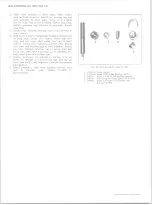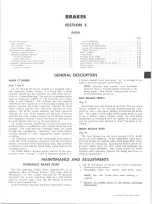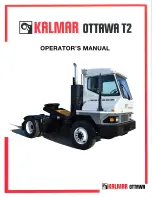
BRAKES 5-12
Fig. 28— Removing Hold Down Cup
Light Scoring
Light scoring of the disc surfaces not exceeding .015
inch in depth, which may result from normal use, is not
detrimental to brake operation.
Checking Lateral Runout
Tighten the wheel bearing adjusting nut until all of the
play is out of the bearing. It should be just loose enough
to allow the wheel to turn. Fasten a dial indicator to
some portion of the suspension so that the point of the
stylus contacts the rotor face approximately one inch
from the rotor edge. Set the dial at zero and move the
rotor one complete rotation, checking the indicator as
Fig. 2 9 — Backing Plate Contact Surfaces
the rotor moves. After checking the runout, readjust
the wheel bearing. (See Section 3.)
Checking Parallelism
To check for parallelism, measure the thickness of
the rotor at four or more points around the circum
ference of the rotor (use micrometers). All measure
ments must be made at the same distance in from the
edge of the rotor.
DRUM REAR BRAKES (Fig. 25)
Brake shoe adjustment takes place when brakes are
applied with a firm pedal effort while vehicle is backing
up. Applying the brakes moves an actuator which turns
the star wheel and lengthens the adjusting screw assem
bly. This action adjusts the shoes until clearance between
the lining and drum is within proper limits.
Should low pedal heights be encountered, it is recom
mended that numerous forward and reverse stops be
performed with a firm pedal effort until a satisfactory
brake pedal height results.
NOTE:
Frequent usage of an automatic trans
mission forward range to halt reverse vehicle
motion may prevent the automatic adjusters
from functioning, thereby inducing low pedal
heights.
Retracting Self Adjusters (Fig. 26)
A lanced “knock out” area is provided in the backing
plate. This hole is for service purposes in the event
retracting of the brake shoes is required to remove the
drum. However, in order to back off the adjuster, it will
be necessary to hold the actuating lever away from the
starwheel.
Drum brake lining can be inspected through slots in
the flange plate. The portion of lining visible through the
slot will not necessarily be the area of maximum wear and
extra caution is necessary to make sure lining is replaced
prior to the point where the remaining thickness, as
viewed through the inspection slot, is as follows:
Series 10 (bonded lining), 1/16”
Series 20, 30 (riveted lining), 3/16"
Brake Drums, Shoes and Linings
NOTE:
If brake drums are worn severely, it
may be necessary to retract the adjusting screw
as previously outlined.
Removal (Figs. 27 and 28)
1. Raise the vehicle on hoist or place on jack stands.
2. Loosen check nuts at forward end of parking brake
cable sufficiently to remove all tension from brake
cable.
3. Remove brake drums.
NOTE:
Since boots are recessed in grooves on
wheel cylinders to prevent pistons from leaving
cylinders, it is not necessary to install wheel
cylinder clamps when brake shoes are removed;
however, brake pedal must not be depressed
while drums are removed.
4. Unhook brake shoe pull back springs from anchor pin
and link end, using Tool J-8049.
5. Remove the actuator return spring.
10-30 CHEVROLET TRUCK SERVICE MANUAL
Summary of Contents for 10 1971 Series
Page 1: ......
Page 96: ......
Page 100: ...10 30 CHEVROLET TRUCK SERVICE MANUAL Fig 4 10 30 Series Truck Frame FRAME 2 4 ...
Page 120: ......
Page 203: ...ENGINE 6 25 Fig 22L Engine Mounts 10 30 CHEVROLET TRUCK SERVICE MANUAL ...
Page 215: ...ENGINE 6 37 REAR M O U NT Fig 21V Engine Mounts 10 30 CHEVROLET TRUCK SERVICE MANUAL ...
Page 218: ......
Page 249: ......
Page 324: ......
Page 340: ......
Page 365: ...10 30 CHEVROLET TRUCK SERVICE MANUAL Fig 43 Power Steering Pump M ounting STEERING 9 25 ...
Page 368: ......
Page 386: ......
Page 390: ...ELECTRICAL BODY AND CHASSIS 12 4 10 30 CHEVROLET TRUCK SERVICE MANUAL ...
Page 391: ......
Page 428: ......
Page 432: ......
Page 449: ...SPECIFICATIONS 9 10 30 CHEVROLET TRUCK SERVICE MANUAL ...
Page 463: ......
Page 464: ......
Page 465: ......
Page 466: ......





































